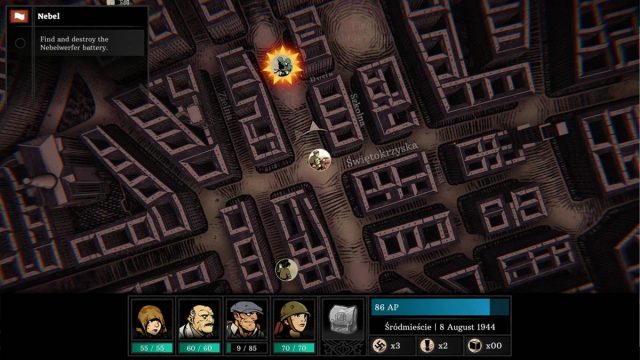Warsaw Review
Winning Is Not an Option
After going to a fantasy realm in Regalia: Of Men and Monarchs, developer Pixelated Milk stays much closer to home with Warsaw. The game takes place during World War II and is centred around the 1944 Warsaw Uprising, an event that will be less known in those nations that were more focused on the war’s western front in Europe but one very much worthy of being educated on. Though the game makes a strong first impression with its chilling premise and a decent gameplay loop, it fails to carry that forward into the full experience.
Players take on the role of the de facto leader of the uprising, trying to keep it going through the full 63 days that it historically lasted, which ultimately resulted in the city being razed. To begin with, players are given three agents, drawn from many walks of life and hoping to lend their skills to the cause. Further agents are added over the course of the campaign through post-mission events, with a grand total of fifteen that can appear, though players will maybe only get around half of these during a single campaign. The game sees players send a team of up to four agents out on a mission to one of the six districts, which usually takes between three to five days, after which they return to base and prepare for the next mission.
Those who know about the uprising will note this endeavour is ultimately doomed, and this comes through in the game with a rapidly dwindling population count displayed at the end of each mission alongside increasing attrition counters for each district and ever reducing morale and momentum totals. All districts provides daily resources, though these decrease as each one deteriorates, before eventually surrendering entirely should any of its elements hit rock bottom. It thus becomes a careful balancing act of trying to keep as many districts going for as long as possible, but only one mission can be undertaken at a time, and those districts whose missions not chosen will suffer a little extra as a result. Many players should expect to end the game with just one or two districts still standing. As campaigns go, it’s not particularly deep, but there’s enough to sustain the seven to a dozen hours or so each run lasts.
There is also a risk element to selecting the apparently randomised missions: destroying a tank is much tougher than retrieving a set of supply drops, but may be necessary to undertake to keep a district going. After each mission, agents will need some time to recuperate, so players will need to have two teams of agents, potentially adding some generic characters to bolster their ranks, and swap between them each mission. Each of the regular agents can also rank up by spending medals attained during missions, each rank granting a choice of one of two extra skills, with agents able to equip up to four skills to take into each battle.
Each mission sees the player’s squad roaming the streets of the selected district, looking out for enemies, supply crates, or special events. Some enemies will be on the lookout and start a fight immediately if they have a line of sight to the player within an indicated range, while others can be engaged at will. However, given the emphasis on resource management and lack of rewards for winning a single fight, there is little benefit in getting into one unless the mission calls for it. Meanwhile, special events — which also occasionally come up post-mission — will often give players a small number of choices. These can have wide-ranging effects, including much-needed boosts in morale, but can also go the other way and negatively affect the uprising. Ultimately, these feel a bit too arbitrary as opposed to something that players can use tactically so it often doesn’t feel worth going out of one’s way to seek them out.
Combat gives each side eight positions on a four-by-two grid, some of which are occupied by barricades. Each side alternates across a number of actions per turn, usually corresponding to the number of combatants left standing. The player always goes first each turn, and if any combatants are defeated, that side will lose an action on the current turn and any following ones. Each agent has a stamina total that begins and maxes at three, meaning that though characters can go multiple times, players can’t just fully load up on a single powerful ability. Each action uses at least one stamina, with one stamina regained each turn, and a lower stamina total also applies additional hindrances such as reduced accuracy.
Having a healer in the squad is absolutely imperative, as is making sure that the barricades are being utilised, or created if necessary, as any character stood behind a barricade will find that most of the damage is absorbed. This goes for enemies as well, but in addition to attacks that affect multiple targets, there are skills that can affect both ally and enemy positions, making positioning an important part. Further management comes into play through ammo and the limited amount of carrying slots available. Each skill uses up a certain amount of short, long, or heavy ammo; usually the more powerful the skill, the more ammo it uses. Those who go all out will quickly run out, as ammo is not hugely plentiful. Warsaw strikes a pretty good balance in its handing out of resources. Running out feels like wastefulness or poor decision making on the player’s part, while loot crates are rare enough that players can’t rely on finding them, though it’s a highly satisfying boon when they do.
All of this makes a good, if unremarkable, first impression. The missions are enjoyably quick, and there isn’t much to get bogged down in back at base. There are options to repair broken weapons gained from missions, but they aren’t any improvement over the default weapons so this really amounts to a waste of resources that are much better spent elsewhere. Meanwhile, the dark visuals and premise do a good job setting the stage, even if the audio is fairly underwhelming. Unfortunately, Warsaw fails to utilise it effectively. There is a prime opportunity for some personal stories, and while there are some codex entries as well as a quick epilogue detailing what happens to each of the surviving agents afterwards, that’s pretty much it. The special events try to sow in some environmental storytelling, but the attempt is negated by having to be generic and geared towards having players primarily care about whether they help numbers go up or down.
This means that after players have gotten used to the game and the ins-and-outs after this first mission, there’s nothing to look forward to. There is also nothing to indicate what is actually happening in the city itself. The only indication players have of things not going well for the uprising is simply the fact that all the numbers are changing. Given the historical context, it’s entirely understandable that “winning” isn’t an option, but Warsaw offers no context as to why. It devolves into players simply focusing on how to sustain their numbers for as long as possible rather than what is actually happening, and offers little reward for successfully doing so.
Warsaw starts well enough. Its eye-catching premise and style do a good job getting players’ initial attention, while the brisk gameplay loop gets players up to speed quickly. However, the loop gets tiresome a short while in, with rather shallow depth and no narrative to support it, and so the experience of the game itself will not linger too long in the memory. But if nothing else, Warsaw still gives encouragement for others to learn more about one of the darker times in history and find further respect for those who fought through it.
Disclosure: This review is based on a free copy of the game provided by the publisher.


Enjoyable gameplay loop
Real-world scenario worth exploring and highlighting
Doesn't make good narrative use of its setting
Lacks staying power










Recent Comments